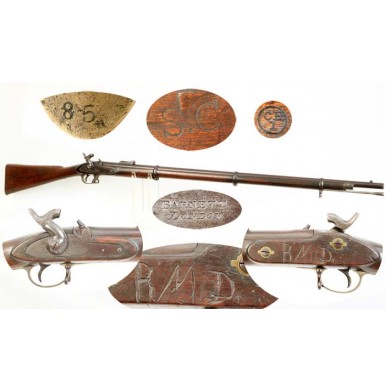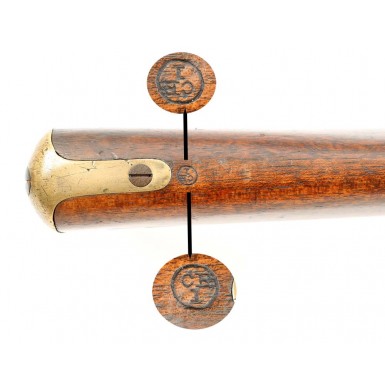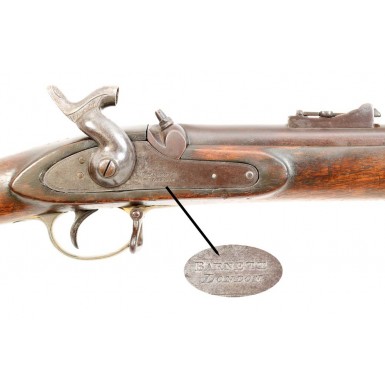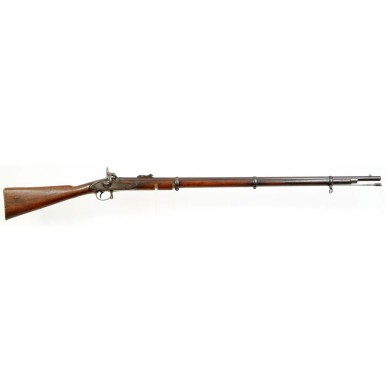Confederate SC Marked P-1853 by Barnett - #85
- Product Code: FLA-3128-SOLD
- Availability: Out Of Stock
-
$1.00
For collectors of Confederate marked & imported Enfield rifle muskets, the examples marked for specific Confederate state purchases are the among the most sought after and highly prized examples. They are also some of the most difficult examples to acquire. The Georgia “G”, South Carolina “SC”, Louisiana “Star-L” and North Carolina “NC” marked weapons demand high premiums and are often the centerpieces of advanced Confederate Enfield collections. It has long been argued that the state markings of these guns were applied in the south, and were the result of disagreements between Confederate state governments and the Confederate central government as to the disposition of state arms upon their arrival. Both of these theories are provably false. The state letter markings applied to the obverse buttstocks of both Georgia and South Carolina purchased Enfields were applied in England, likely as part of the inspection process when the gun were viewed, marked and numbered. This is verified by the fact that the die sizes and fonts for two variants of the “SC” and “G” marks match, indicating the dies were from the same source, and the marks likely applied at the same location. Additionally, the first Georgia (and Louisiana) purchased arms to arrive in the south were those aboard the Fingal, which arrived in Savannah’s harbor on November 13, 1861. These 1,100 Georgia guns were initially a point of contention between Georgia’s Governor Brown and the Confederate War Department, which wanted to dictate to whom the arms would be issued. Although the Official Records (and Wiley Swords’ Firepower From Abroad suggest that these arms were finally all issued to Georgia regiments, an extant example of at least one Fingal Georgia “G” Enfield (which remains in the original family of the Tennessean who carried it during the war today) suggests that the guns that arrived during the early days of the war were not issued quite so carefully.
As the clouds of war gathered during the latter portion of 1860 and early 1861, the various Confederate states took it upon themselves to obtain arms from whatever sources were available, to prepare for their own defense once hostilities broke out. Many southern states sent representatives to England, in order to enquire about, and potentially arrange the purchase of, English military pattern arms. South Carolina was particularly well suited to obtain arms from England, as the state had a long standing trade relationship based upon cotton exports and finished goods imports, mainly through the port in Charleston, SC. The Charleston based firm of John Fraser & Company, along with their Liverpool based branch Fraser, Trenholm & Company and the New York offices of Trenholm Brothers would establish one of the most important trade and financial support groups for the Confederacy during the course of the war. Their pre-war business connections and vast experience with import-export allowed them to build a fleet of blockade-runners and supply the Confederacy with many essential items, for a substantial profit. However, arms purchases were not only made once the war began. During 1860, one Charleston area militia unit, the Georgetown Rifle Guards, were armed and equipped with English Enfields and a six-pound Blakely Rifle by their benefactor, Plowden C.J. Weston. Weston was a wealthy plantation owner in Georgetown, located about 60 up the coast from Charleston. Records indicate that the English arms were purchased through a Charleston based gun dealer. The “Georgetown Rifle Guards’ would become Company A of the 10th South Carolina when the local militias were mustered into state, and later Confederate service. Other pre-war purchases include at least 40 Enfields offered for sale by Gravely & Pringle a month before the war broke out. Their add in the Charleston Mercury on March 19, 1861 noted that “forty celebrated Enfield rifles with bayonets” were available for sale. In May of 1861, less than a month after the opening of hostilities, General Wade Hampton of the Hampton Legion ordered 400 Enfield rifles and rifled cannon from England as well. While it is probable that Fraser, Trenholm & Company coordinated most of the early importation of Enfields for the state of South Carolina, state purchasing agents were also dispatched to England. Benjamin Franklin Evans of Charleston was sent to England on behalf of the state of South Carolina in March of 1862, and was authorized to spend up to $60,000 for arms and materiel. While not all of the South Carolina contracts or purchasers have been identified, what appears clear is that at least two different contracts were entered into by the state to obtain Pattern 1853 Enfield Rifle Muskets in England. The first contract appears to have been for 2,000 Enfields, and was probably entered into about the same time as the 2nd Sinclair, Hamilton & Company contract for Enfields with the Confederate central government, during the fall of 1861. These guns are inspected with the Confederate viewer’s mark of a JS / (ANCHOR) and have an engraved inventory number on their buttplate tangs. They are additionally marked with the letters S.C on the obverse buttstock. At least four sizes of this “SC” mark are known, with most of these engraved number guns having a .55” SC, sometimes accompanied by an additional “small SC” that is about .3” tall and usually appears on the top of the buttstock comb, although it can sometimes be found on the obverse stock as well. The other contract was apparently for 1,000 P-1853 Enfields, and was with the firm of J.E. Barnett and Sons of London. Like the Barnett Enfields purchased by the state of Georgia, these guns have their inventory numbers stamped into the toe of the buttplate, and bear the inspection mark of viewers Curtis & Hughes, a CH / 1 within a circle on the top of the stock comb, forward of the buttplate tang. The “SC” mark on the obverse stock is larger than the mark found on the guns with engraved numbers, being about .70” tall, and of the same size and font as the “G” found on Barnett Georgia contract Enfields. Survival of state marked Confederate P-1853s is quite low, with less than 40 of the South Carolina marked guns are known to exist out of at least 3,000 that were purchased. This gives a survival rate of slightly more than 1%. To date less than a dozen of the “Big SC” Barnett guns are known, making them among the rarest of Confederate Enfields, along with the extremely scarce North Carolina and Louisiana marked P-1853s.
The Barnett “Big SC” South Carolina Enfield Rifle Musket offered here is in about VERY GOOD condition, and is essentially complete and original with some minor stock repair of a couple of old cracks. The gun bears the “large” S.C mark on the obverse stock, and is stamp numbered 85 in the toe of the brass buttplate, making it the second lowest numbered South Carolina marked Barnett Enfield known. The next closest number known to survive is number 87 in the collection of the South Carolina Confederate Relic Room & Military Museum, having formerly been part of the C.A. Huey collection of Confederate purchased English arms. This example also has the expected CH / 1 inspection mark on the comb of the stock. The mark is very deeply struck and extremely clear. The lock plate of the musket is clearly marked forward of the hammer BARNETT / LONDON. The firm of John Edward Barnett & Sons was one of the oldest and most prominent of the London gunmaking companies. They could trace their history to 1628, and in 1637 King Charles I appointed a Barnett the first president of the gunmakers guild. The company remained in business until just before World War I. While it is impossible to know for sure, surviving documents seem to indicate that all of Barnett’s production of Enfield pattern arms during the first 2-3 years of the Civil War (that were not previously contracted for by the British Government) went to fill Confederate arms contracts from S. Isaac Campbell & Company, and the various Confederate States. There is no crown mark to the rear of the hammer, and the lock plate shows the double line engraving typical of one produced on contract in Birmingham or The Regions. The interior of the lock is marked simply PRITCHETT and with the umber 28. RT Pritchett & Son were a major London gunmaking firm whose marks show up regularly on Civil War era Confederate Enfields, both as finished products and as the furnisher of parts to other makers. The bottom edge of the lock has the assembly mating mark | | | cut into it with a file. The breech of the barrel was marked with the standard London commercial proof and view marks, without a gauge marks, but due to a very old cleaning, only the most minor remnants of the marks remain visible. Under the barrel, the gauge mark 25 is struck, indicating .577 caliber. The initials RP (again probably indicating Pritchett) are struck, along the numbers 101 and 70. The two sets of mating marks \ / and | | | are cut with a file into the bottom of the barrel as well. The comb of the stock, forward of the buttplate tang, is marked with the deeply struck Confederate view (inspection) mark of Curtis & Hughes, a CH / 1 in a circle. Isaac Curtis and Charles Hughes were English gunmakers hired to serve as inspectors to view Confederate purchased arms. They appear to have primarily worked inspecting arms provided by Barnett, as their mark is most often found on Barnett produced Enfields, as well as surplus arms sold the Confederacy by Barnett like P-1851 Mini” Rifles and Brunswick Rifles. The Confederacy must have been particularly happy with Curtis’ work, as he emigrated to the south in late 1863 to work at the Confederate manufactory in Fayetteville, NC. The obverse buttstock is clearly stamped with the large S.C South Carolina state ownership mark. The ramrod is a period original but is unmarked and bears no number, which is typical of the rammers found in Barnett “stamp numbered” Confederate guns. To date no known example of a Confederate marked and numbered Barnett Enfield has appeared with a numbered ramrod. While the guns with engraved numbers on the buttplates also had the inventory number engraved on their ramrods, there is no indication that any such marking took place on the Barnett guns with stamped numbers. The stock flat, opposite the lock is deeply carved with the initials R M D and the remainder of the last name AVIS is lightly scratched into the stock after the “D”. The musket was previously in the well known collection of South Carolina and Confederate militaria of Ashley Halsey Jr. Mr. Halsey was a Charleston, SC native and a founding member of the South Carolina Arms Collectors Association, a Fellow of the Company of Military Historians and was a noted author, historian and journalist. Halsey authored two books on the Civil War; The Last Duel In The Confederacy and South Carolina Began Preparing For War in 1851. Halsey was also a writer and editor with The Saturday Evening Post, but is probably best remembered to arms collectors as the long time editor of the National Rifle Association magazines The American Rifleman and The American Hunter. In 1998 Freeman Fine Arts Auctions in Philadelphia, PA sold Mr. Halsey’s collection. As Mr. Halsey was a known specialist in South Carolina Civil War memorabilia, it is unclear if he obtained the musket directly from the family, or through other means, but it is his attribution that associates the “R M Davis’ carving with R.M. Davis of the 20th South Carolina Volunteer Infantry.
The 20th South Carolina Infantry was formed during the winter of 1861-1862 in Orangeburg, SC. The regiment spent its initial service in South Carolina, particularly on rotating garrison duty on Morris Island, manning the ramparts of Battery Wagner. The 20th South Carolina Infantry saw its first combat during the attack and siege of Battery Wagner, which took place between July 10 and September 6, 1863. During that battle the 20th lost 9 killed and 24 wounded. The initial attack on Battery Wagner is forever immortalized in the movie Glory, which culminates with the Federal attack, lead by the 54th Massachusetts Infantry regiment of colored troops, assaulting the battery and being repelled. On May 16 of 1864 the 20th SC was transferred to the Army of Northern Virginia, where it was added to Kershaw’s Brigade and subsequently participated in the Battle of Cold Harbor (May 31-June 12, 1864). From there they moved to Petersburg and with the brigade remained in the trenches there until mid-August, when the brigade was sent to the Shenandoah Valley to reinforce General Jubal Early. The 20th (along with the rest of Kershaw’s Brigade) was ordered to return to Petersburg in mid-September to reinforce the Confederate forces there, but only a few days later Early was attacked in the valley by Federal forces and the brigade was sent back to reinforce him. In October the 20th took part in the Battle of Cedar Creek with the rest of Early’s Army. In November of 1864, with the Federal army threatening most of South Carolina, Kershaw’s Brigade (now Kennedy’s Brigade) was returned to South Carolina to assist in the defense of that state. After fighting minor delaying actions, but primarily retreating in the face of overwhelming force, the brigade, including the 20th SC retreated north, eventually joining with the remnants of the Army of the Tennessee under General Joseph Johnston. Under Johnston’s leadership the 20th participated in the Battle of Bentonville (March 19-21, 1865), where the 20th lost 7 more men. Initially the regiment had numbered about 1,200, but by the end of the Bentonville campaign, only 243 men were still on the duty rolls of the regiment. On April 9, 1865 the 20th SC and 2nd SC were consolidated to a single command and when the consolidated regiments surrendered at Goldsboro, NC with the rest of the Army of Tennessee, only 213 men would remain out of a total of about 2,600 that had severed in the two regiments. RM Davis was a late addition to the 20th South Carolina Infantry. He mustered into Company D of the regiment on March 16, 1864, and is listed as having joined at Sullivan’s Island. Unfortunately, late war Confederate records are problematic and incomplete at best. Only 3 muster cards remain showing Davis’ service, which indicate that he was present through June of 1864, but that by February of 1865 he was on a list of those reported absent from the regiment. At the very least it appears that Davis traveled with the regiment to Virginia and was probably present at the Battle of Cold Harbor. Whether he was lost, wounded, killed, missing or simply left after that battle (or sometime there after) is not clear. I can find no records of Davis after June of 1864, other than being listed as absent in February of the following year. What small amount of information that I could located about Davis is included with the musket.
The gun has a mostly smooth, somewhat oxidized, dark brown patina that appears to be a combination of real, freckled oxidation and age, over an old applied plum brown finish. The majority of the barrel metal is smooth, probably from an old cleaning, with some scattered light pitting present in small patches along the barrel and breech. The barrel bands all have the same, deep chocolate patina as the barrel. The barrel bands all retain their original “doughnut” protectors that secure the tension screws, preventing their loss when the bands are loosened. The bore of the musket rates about GOOD+. The bore is dark with a heavily seasoned appearance, but retains good, visible rifling along its length. There is even light pitting along the entire length of the bore, and a few patches of more significant roughness and erosion and some areas of moderate pitting as well. A good scrubbing might improve the condition of the bore by removing old fouling and debris. The lock functions perfectly on all positions and remains very crisp and tight. The lock plate retains traces of original finish, mixed with a darker plum brown and mottled gray patina. The lock is mostly smooth with some scattered flecks of minor surface oxidization over the mottled patina. Both original sling swivels are present, and are likely original to the musket. The original rear sight is present as well, and matches the balance of the musket perfectly. As previously noted, the original ramrod is present in the channel under the barrel. It is full-length and retains good threads on the end of the rod. The brass furniture has a medium bronze patina and is quite attractive. The inventory number 85 is stamped into the bottom toe of the butt plate. The stock is in about VERY GOOD condition overall and is solid, complete and full length. The stock does show a very old and extremely well executed repair to a crack that runs diagonally through the obverse of the lock mortise at an upward angle to the barrel channel, under the rear sight. This was repaired a very long time ago and is extremely tight and solid. The crack is almost invisible from the exterior, but indications of the repair can be seen in the barrel channel. There is another, much more minor grain crack present on the reverse of the stock running diagonally from the barrel channel to the stock flat. This is also tight and stable, and does not appear to be a serious issue. Both cracks should be clearly visible in the photos below. As would be expected, the stock shows numerous scattered bumps, dings, nicks and even some tiny minor gouges, all indications of significant use in the field. The stock has a nice dark and untouched look to it, some areas that were handled a lot showing the sheen of a 100+ year-old banister that has been burnished by thousands of hands over the years. The stock retains very strong edges and lines throughout, with no indication of having been sanded. As mentioned above, the initials RMD are heavily carved into the stock flat, with the remains of the last name “Davis”, the “AVIS’ more lightly scratched into that location.
All in all this is simply a great looking example of a very scarce and very desirable Confederate purchased, South Carolina marked Enfield rifle musket that clearly saw significant use, and has a tangible connection to a specific Confederate solider and the 20th SC Infantry. The gun is complete and correct (with the few minor exceptions as noted above), and has nice, legible markings throughout. Any state marked, Confederate purchased Enfield is a scarce item, and that scarcity, their overall desirability and the infrequency of their appearance on the market has driven prices to almost absurd levels over the last few years. In 2005 an SC marked P-1853 in slightly worse condition sold at auction for well over $8,000, and in 2007 a superb example sold at auction for more than $25,000! While no one would ever call this a superb condition gun, it has the look of an old warrior that saw lots of service in defense of the south and a wonderful overall appearance. With less than a dozen of the “Large SC” Barnett produced South Carolina P-1853s known to exist, it could be a very long time before another one of these hits the market. The gun comes from a famous collection, has a solid attribution to a South Carolina solider and probably spent its entire service life with the men of the storied 20th South Carolina Infantry. This is a gun that you wish could talk. This gun could well be the centerpiece of your Confederate Enfield collection, and it is unlikely that a more fairly priced example will appear for sale anytime soon.
SOLD








